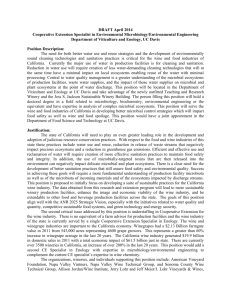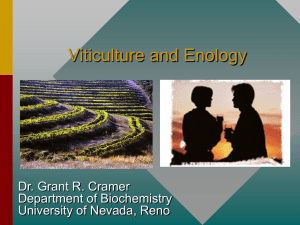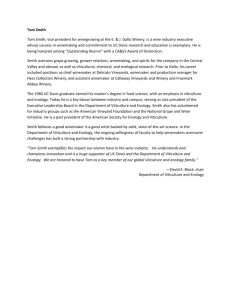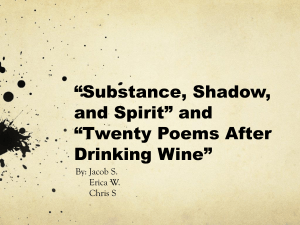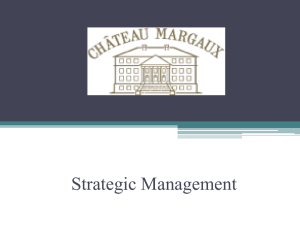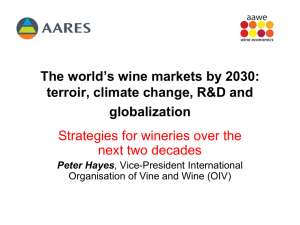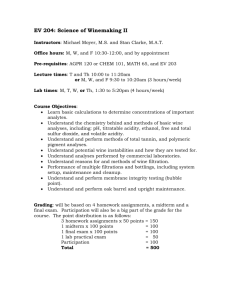View Syllabus
advertisement
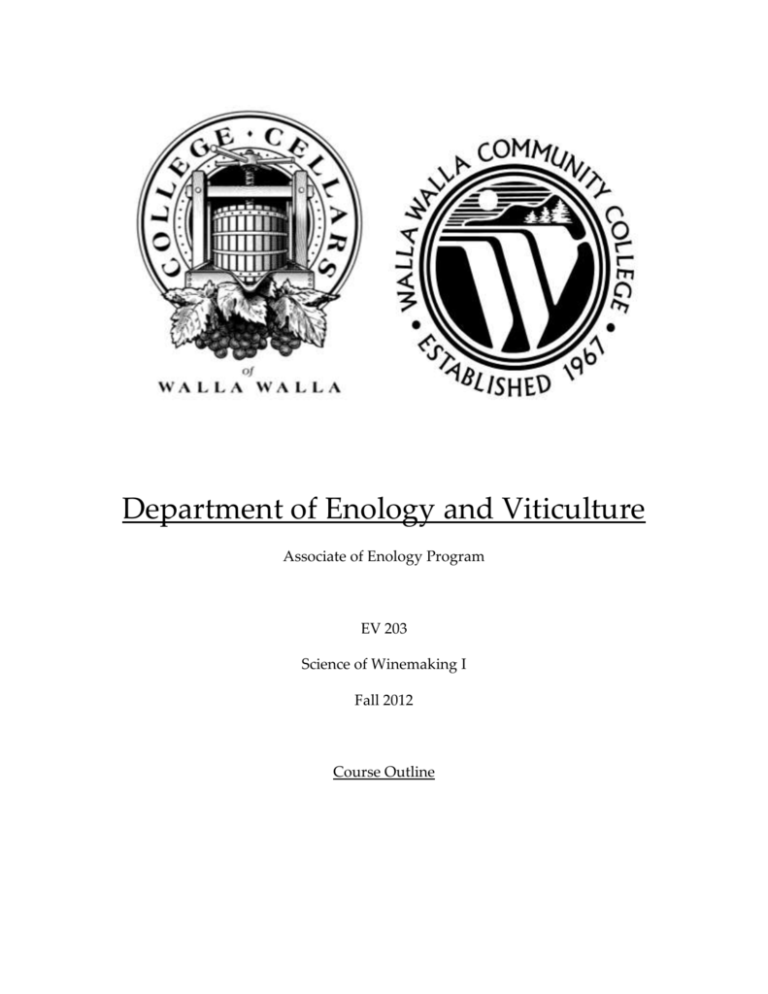
Department of Enology and Viticulture Associate of Enology Program EV 203 Science of Winemaking I Fall 2012 Course Outline Instructor: Timothy Donahue Co-Instructor: Sabrina Lueck Course: EV - 203 The Science of Winemaking I Contact: Email: Tim.Donahue@wwcc.edu Phone: Office: 509-524-5172 Formal Contact Hours: Lecture times: August 15th to September 2rd and November 28st through December 2nd 9:00 am to10:20am, Monday through Friday. Office Hours Office Hours: 1:00 – 2:00pm Monday through Friday and by appointment. Course Objectives: This course aims to develop an understanding of the chemistry of winemaking, the concepts and practical aspects of wine chemical analyses, the impacts of winemaking strategies on sensory impacts of wines and the production procedures for white, rose’ and red table wines. Expected Learning Outcomes: Understand the basic chemistry and methods of wine production. Understanding of basic winery maths, including, but not limited to practical volume calculations, acid additions, water additions, nitrogen additions as well as acidification and de-acidification in a winery environment. Receive information about types of winery environments and methods to respond to a variety of winemakers, equipment and sanitation regimes. Receive information and repeat chemical analyses and sampling techniques including: Bunch count and weight, yield estimations pH and titratable acidity. Students will be expected to be able to independently reproduce wine production techniques within the confines of a theoretical wine assignment. Understanding of methods to evaluate, manage and modify the winery environment through cleaning, sanitation techniques. The overall goal of this course is to o Receive information about wine chemistry through observation and hands on learning o Respond to the various winemaking situations by distinguishing, differentiating and application of a variety of winemaking techniques. o Organize the winery environment to be able to adapt, adjust, alter and/or change the outcome of a wine by understanding a variety winery equipment and additions. Grading Theoretical Wine Assignment = 75 points 2 Homework assignments @ 25 points each = 50 points 1 Math Quiz = 25 points 1 Midterm exam x 100 points = 100 points 1 Final exam x 125 points = 125 points @ 25 points Total = 400 points Attendance: Attendance is mandatory, and will be monitored and documented intermittently. Lack of attendance will have a deleterious impact on the final outcome. Work does not count as an acceptable “excuse” and will be docked at 40 points (10% overall grade) per occurrence. Harvest Activities: All students will be provided with a list of tasks to be performed throughout the harvest for your practicum. Your employer will be responsible for signing off on each of these tasks. If you need help in this endeavour, please let the Director or I know. E-Mail: Harvest is a highly unpredictable season and scheduling any activities with absolute certainty is improbable. Scheduling changes may be frequent and on short notice through e-mail. It is the student’s responsibility to check your e-mail to remain informed. Extra Credit Extra credit assignments may be given from time to time at the end of lectures or as a part of quizzes. Students must be in attendance for the opportunity to complete these assignments. Penalty for Late Submission of Assignments Assignments must be submitted by their deadline. There will be a penalty of 10% of the total grade for each day (or part of a day) that an assignment is late, up to a maximum penalty of 50% of the total grade. After 5 days, all assignments will receive a grade of 0 (Zero). Occupational Health and Safety Students are required to read and sign the “Student Handbook” for the Center for Enology and Viticulture. This information is available in the front office. Please see the course coordinator if there is anything that is unclear in this document or with suggestions to improve the content. Textbooks and References Required: Margalit, Y., Winery Technology & Operations: A handbook for small Wineries (2003) The Wine Appreciation Guild Optional Texts: Boulton, R.B., Singleton, V.L., Bisson, L.F., and Kunkee, R.E. (1998) Principles and Practices of Winemaking. Kluwer Academic/Plenum Publishers Iland, P., Bruer, N., Ewart, A., Markedies, A., and Sitters J., (2004) Monitoring the winemaking process form grapes to wine – Techniques and concepts . Patrick Iland Wine Promotions PTY. LTD. Jackson, R.S. (2008) Wine Science, Principles, Practice Perception. Third edition Academic Press (A personal favorite) Zoecklein, B.W., Fugelsang, K.C., Gump, B.H., Nury, F.S. (1999) Wine Analysis and Production. Virginia Tech (Excellent Enological book, very specific and well written) Required for EV-204, but will be helpful for some lab analysis: Iland, P., Bruer, N., Edwards, G., Weeks, S. and Wilkes, E. (2004) Chemical Analysis of grapes and wine: techniques and concepts. Patrick Iland Wine Promotions PTY. LTD.* Class Schedule (UPDATED) # 1 Date Aug 13 2 Aug 14 3 4 5 Aug 15 Aug 16 Aug 17 Aug 21 Aug 20 Winery Equipment Pre Harvest Preparations - Basic Winery Maths Vineyard Sampling basic Juice analysis Lab: pH, TA, Brix - Sign up for Lab Math problems Due /Review - Quiz#1 Aug 22 Warning: Contains Sulfites and Acid Basics 7 Aug 23 Aug 24 Aug 27 8 Aug 28 ETS LABS – Barrel maintenance RE-WINE Re-coopering barrels Yeast and the alcoholic fermentation ML Homework Distributed White Wine Production 9 10 11 12 Aug 29 Aug 30 Aug 31 Sept 4 Sept 5 Sept 6th 6 Sept 7th Dec 3rd Lecture Topic Welcome back, overview, work ethics Homework Distributed (2 Assignments) Theoretical Wine and Math problems. Winery Cleanliness + safety (review), Barrel maintenance (Wine Library – After Class) End of Season Viticulture Seminar Tour: Cayuse Winery Red Wine Production Enzymes and Other Additives Spoilage Organisms The Malo-lactic Conversion ML Homework Due Final Exam: 9:00 AM Theoretical Wine Assignment Due Deadline for harvest Journals (Earlier OK!) Reading (Margalit) 100-104 13-16 1-11 57-75 5-7, 49-55 Iland 26-31, 32-43 57-75 33-36, 41-48, x(operations) and xi (Flow chart) JEFF POPICK 37-41, xi(Flow chart) 42 143-149 75-78 (EV-286)

